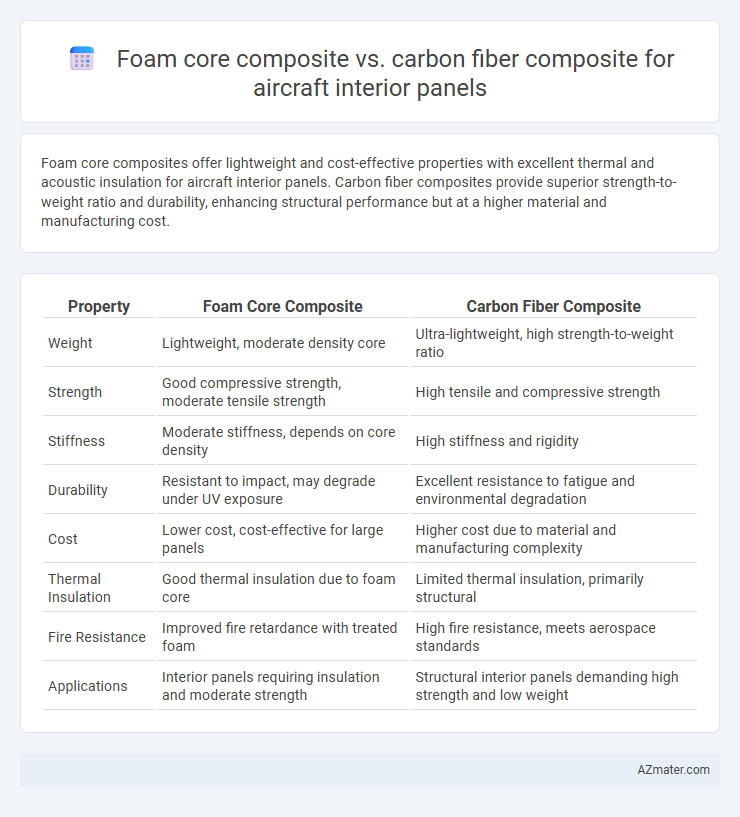Foam core composites offer lightweight and cost-effective properties with excellent thermal and acoustic insulation for aircraft interior panels. Carbon fiber composites provide superior strength-to-weight ratio and durability, enhancing structural performance but at a higher material and manufacturing cost.
Table of Comparison
| Property | Foam Core Composite | Carbon Fiber Composite |
|---|---|---|
| Weight | Lightweight, moderate density core | Ultra-lightweight, high strength-to-weight ratio |
| Strength | Good compressive strength, moderate tensile strength | High tensile and compressive strength |
| Stiffness | Moderate stiffness, depends on core density | High stiffness and rigidity |
| Durability | Resistant to impact, may degrade under UV exposure | Excellent resistance to fatigue and environmental degradation |
| Cost | Lower cost, cost-effective for large panels | Higher cost due to material and manufacturing complexity |
| Thermal Insulation | Good thermal insulation due to foam core | Limited thermal insulation, primarily structural |
| Fire Resistance | Improved fire retardance with treated foam | High fire resistance, meets aerospace standards |
| Applications | Interior panels requiring insulation and moderate strength | Structural interior panels demanding high strength and low weight |
Introduction: Comparing Aircraft Interior Panel Materials
Foam core composites offer lightweight and cost-effective solutions for aircraft interior panels with excellent thermal insulation and impact resistance properties. Carbon fiber composites provide superior strength-to-weight ratios, enhanced durability, and high stiffness, making them ideal for high-performance and safety-critical components. Evaluating these materials involves balancing weight reduction, mechanical performance, manufacturing complexity, and cost efficiency for optimized aircraft interior design.
Overview of Foam Core Composites
Foam core composites consist of a lightweight foam core sandwiched between two composite face sheets, offering excellent stiffness-to-weight ratios ideal for aircraft interior panels. These materials provide enhanced thermal insulation, acoustic damping, and cost-effective manufacturing compared to traditional composites. Foam core composites enable weight reduction while maintaining structural integrity, making them suitable for cabin walls, ceiling panels, and flooring in commercial and private aircraft.
Overview of Carbon Fiber Composites
Carbon fiber composites, consisting of carbon fibers embedded in a polymer matrix, offer exceptional strength-to-weight ratios and enhanced stiffness, making them ideal for aircraft interior panels. Their superior impact resistance and fatigue durability contribute to improved safety and longevity compared to foam core composites. These materials also enable weight reduction, which is critical for fuel efficiency and overall aircraft performance.
Weight and Strength Analysis
Foam core composites offer a lightweight solution with moderate strength, making them suitable for non-structural aircraft interior panels where weight reduction is essential. Carbon fiber composites provide superior strength-to-weight ratios, delivering enhanced durability and impact resistance crucial for load-bearing interior applications. Weight savings with carbon fiber can reach up to 30-40% compared to foam core composites while significantly improving stiffness and tensile strength.
Cost Efficiency and Affordability
Foam core composites offer significant cost efficiency and affordability advantages over carbon fiber composites for aircraft interior panels due to lower material prices and simplified manufacturing processes. While carbon fiber composites provide superior strength-to-weight ratios, their high raw material costs and labor-intensive fabrication result in substantially higher overall expenses. Choosing foam core composites enables airlines to reduce production costs and maintenance budgets without compromising essential performance in non-structural interior applications.
Manufacturing and Fabrication Techniques
Foam core composites for aircraft interior panels utilize a sandwich structure with a lightweight foam core bonded between composite skins, enabling simplified manufacturing through vacuum bagging and resin infusion techniques that reduce cycle time and cost. Carbon fiber composites require more complex fabrication processes, such as autoclave curing and precise layup of carbon fiber prepregs, which provide superior strength-to-weight ratio but involve higher equipment investment and longer production cycles. Both materials benefit from advanced tooling and quality control methods, with foam core composites optimized for rapid prototyping and ease of customization, while carbon fiber composites demand rigorous process control to achieve aerospace-grade mechanical performance.
Durability and Longevity in Aircraft Environments
Foam core composites exhibit excellent impact resistance and lightweight properties but may degrade faster under prolonged exposure to moisture and temperature fluctuations common in aircraft environments. Carbon fiber composites provide superior durability with high tensile strength, resistance to fatigue, and excellent dimensional stability, ensuring longer lifespan in interior panels subject to constant mechanical stress and varying environmental conditions. Aircraft interior panels utilizing carbon fiber composites benefit from enhanced structural integrity and corrosion resistance, contributing to extended service intervals and reduced maintenance costs.
Fire Safety and Regulatory Compliance
Foam core composites and carbon fiber composites differ significantly in fire safety and regulatory compliance for aircraft interior panels. Foam core composites typically require fire-retardant additives to meet FAR 25.853 standards, while carbon fiber composites inherently exhibit higher heat resistance and lower flammability, aligning more easily with FAA and EASA fire testing protocols. Regulatory bodies prioritize materials that demonstrate self-extinguishing properties, low smoke toxicity, and minimal heat release, often making carbon fiber composites preferable for stringent aircraft interior fire safety requirements.
Maintenance and Repair Considerations
Foam core composites offer easier and less costly maintenance and repair for aircraft interior panels due to simpler damage detection and straightforward patching methods, whereas carbon fiber composites require specialized tools and expertise for inspecting and fixing delaminations or cracks. The lightweight nature of carbon fiber enhances fuel efficiency but complicates repair processes with a need for precise fiber alignment and resin curing, increasing downtime and maintenance costs. Foam core panels provide quicker turnaround times in service environments, making them practical for frequent repairs and reducing aircraft ground time.
Conclusion: Selecting the Best Composite for Aircraft Interiors
Foam core composites offer lightweight and cost-effective solutions ideal for non-structural aircraft interior panels, providing sufficient strength and improved thermal insulation. Carbon fiber composites deliver superior strength-to-weight ratios and enhanced durability, making them suitable for high-performance or structural interior components where weight savings are critical. Selecting the best composite depends on balancing factors such as mechanical performance, weight requirements, cost constraints, and specific application needs within aircraft interiors.

Infographic: Foam core composite vs Carbon fiber composite for Aircraft interior panel
 azmater.com
azmater.com